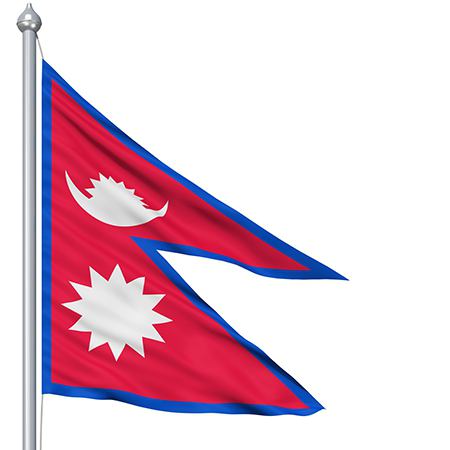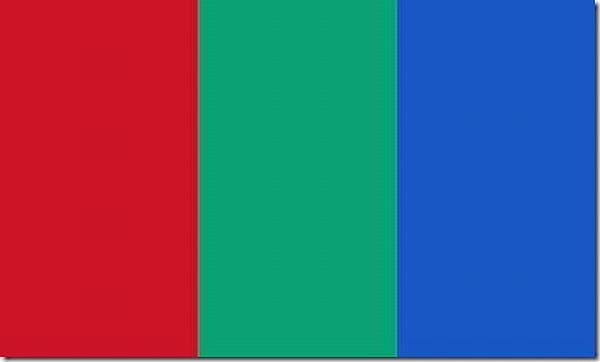Flag of two triangles. National flag and emblem of Nepal - symbols of the country

Hello dear. Today we will continue with the questions of vexillology. In previous posts we discussed identical flags, as well as similar banners, and
Today let's talk about unusual flags, non-standard. In fact, any state policy is unusual and non-standard, for it expresses the individuality of each state, its peculiarity, and if you want a “soul”. But among all we can distinguish the banners, especially striking. I rushed (well, or stuck) in the eyes of the order of 20 flags, which I will tell. But for a start, I will formally divide these banners into 3 groups depending on their unusualness and non-standard. Group I will include flags with non-standard proportions, shapes and sizes, the second one will include banners with individual and rare designs or ornaments. Well, in group 3, I will take all the other flags, which somehow struck me or surprised me.
Today we start with group I.
strengths of the Vatican City State.
The overwhelming majority of countries in the world have a rectangular national flag with proportions (ratios of width and length) of 1: 2, 2: 3, 3: 5 or 5: 7.
But there are a few flags. Which absolutely do not fit into these standards. These are absolutely square cloths of Switzerland and the Vatican, close to the square are the flags of Niger (proportions 6: 7), Belgium (13:15) and Monaco (4: 5), the very narrow and long flag of Qatar (proportion 11:28) and absolutely not similar no matter what the standard of Nepal.
the lost royal family of Nepal.
About the flags of Niger, Qatar and Monaco, we spoke with you in previous posts, therefore we will begin with the most non-standard of all - the state flag of the Federal Democratic Republic of Nepal. I am writing the full name of this state at the moment and I am surprised myself - I just can’t get used to it. Indeed, even until 2008, Nepal was a constitutional monarchy, and the country itself was called the Kingdom of Nepal. But after the horrendous tragedy of 2001, when Crown Prince Dipendra shot his entire family, including his father, the ruling 5 King of Nepal, Birendru Bir Bikram Shah of Nepal, and shot himself, in a country in which there was restless, a civilian broke out war. As a result, the Maoists from the united Marxist-Leninist Communist Party won, which deprived the ruling house of power and proclaimed the country a republic. Now in Nepal, the same instability remains, and how it will continue to continue, which way the country will go, no one can assume. If, over the next 3-5 years, the power elite does not change, then I can almost predict with absolute certainty that the current flag of the state will be changed.
official flag of Nepal.
The flag consists of 2 triangular banners one above the other and the meanings and interpretations of this symbolism are more than enough. The simplest is a combination of the two branches of the Rana dynasty, which ruled and ruled Nepal. The lower flag belongs to the Rana dynasty, from which the prime ministers of the state came out from the end of the 19th century, and the highest belonged to the Shah dynasty, which were related to the Rana dynasty, but it was they who occupied the royal throne from 1911. The union of these two families, as well as their generic symbols, speak of eternity, the peaceful rule of Nepal, while the heavenly bodies shine — the Sun (indicated by the Big Star) and the Moon (the star and crescent). In addition, the sun means determination, and the moon appeases, a combination of 2 beginnings. Hints to the greatest peaks of the Himalayas, the Buddhist Pagoda, as well as a combination of 2 major religions, at the intersection of which is Nepal - Hinduism and Buddhism, also belong to the interpretation of the form of the flag. Dark red is the official color of the Nepalese from ancient times, and the blue bar on the edge means peace and tranquility.
Swiss flag on one of the alpine peaks.
The flag of Switzerland is recognizable around the world. He is one of the oldest in Europe, as he was first seen at the Battle of Laupen on June 21, 1339 as the banner of the so-called Swiss Union, which was an ally of the land of Bern in the fight against the Hapsburg and Burgundians. True, then the rays of the cross reached the edge of the banner, which by the way was rectangular, so the Swiss Union standard resembled the current flag of the Order of Malta. However, from the middle of the 15th century, the cross began to undergo metamorphosis and began to resemble a bit the one we see today. The modern flag was introduced in 1848 as a military one, and its exact proportions were established in the military regulations of 1852. The flag was only in 1889. Just a square shape, because of its military origin, because it is often in the troops that it uses square standards. The red and white colors of the flag are most likely borrowed from the banner of the Holy Roman Empire of the German nation, which were used from the 13th to the 14th century, although the Swiss themselves claim that the flag has not a red color scheme, but a mixture of purple and yellow.
J.A. Dunant
Well, be sure to say that the Swiss flag was taken as the basis for the symbols of such an organization as the International Committee of the Red Cross. A mirror replacement of the flag (red cross on a white cloth) was adopted in connection with the Geneva Convention of 1864, as well as to commemorate the merits of the founder of the organization Jean-Henri Dunant (a Swiss citizen)
flag of the kingdom of belgium
The flag of the Kingdom of Belgium is next. I really like the color combination of the flag of this state. There is something noble, interesting, bright in them. Often, the Belgians themselves do not know that their banner should not be rectangular, but practically square, but this is indeed the case and it is this form that is enshrined in law (article 193 of the Belgian Constitution, though there, why the reverse order of colors: red-yellow-black) . This flag is based on the revolutionary tricolor of 1830, the stripes of which were, however, not vertical, but horizontal. According to the official version, the colors of the standard are taken from the coat of arms of the Duchy of Brabant, which, by the way, became the coat of arms of all of Belgium (a golden lion with red claws and a tongue on a black field).
Flanders and Walloon Coats of Arms
There is another version. It is based on the French flag, since the capital of Belgium, Brussels, belongs to the Walloons, which are historically pro - French. The flag combines the colors of 2 historical parts of the country, two peoples inhabiting Belgium - the black and yellow colors of Flanders and the red and yellow Walloons.
Godffroy of Bouillon in the cotta of the flowers of the coat of arms of the Jerusalem state.
The Vatican flag, which we can observe now, was approved on June 7, 1929 by Pope Pius XI after signing the Lateran Agreements on the establishment of the Vatican as an independent state with the government of Benito Mussolini. The flag was inherited from the Papal States and, despite the apparent simplicity of colors, is unique in its essence. The fact is that often the symbolism on various banners migrated to them from the coats of arms of certain areas or specific feudal lords. And heraldry is a fairly accurate science, in which there are several fundamental rules, the main of which is the impossibility of imposing a metal on a metal.
papal province until 1804
Yellow and white color symbolize gold and silver, respectively, and on the coat of arms you can see such a combination only once in the entire history - this coat of arms of the medieval Kingdom of Jerusalem. The same situation with the flags - a combination of white and yellow - is very rare. Offhand, only the imperial flag comes to mind, but the flag of Brunei. With that, the first and second were exactly white-yellow, and not silver-gold flags, as conceived by the Vatican. The combination of these two precious metals shows the special status of the Vatican. At the same time, the white-and-yellow cloth symbolizes both the golden and silver keys on the coat of arms of the Vatican. An interesting moment, the white and yellow flag of the Papal States was not always. Until 1814, amaranth (red) - yellow flag was used. But after the expulsion of the French, it was decided to replace him.
Coat of arms of the Vatican.
Another important element of the flag is the papal coat of arms, located on a silver strip. The coat of arms is a gold and silver keys, crossed in the shape of the St. Andrew's cross, with beards facing up and out. The keys are connected by a cord, usually red or blue, the two ends of which come down from the handles. The keys are crowned with tiara. A hint of the Gospel of Matthew 16:19 - "and I will give you the keys of the Kingdom of Heaven: and that which you bind on earth, you will be bound in heaven, and that which you will permit on earth, you will be permitted in heaven". The triple crown (tiara) is the "three forces of the Supreme Pontiff: the" high priest ", the" high shepherd "and the" high teacher ". The golden cross of overcoming the triple crown symbolizes the crucifixion of Jesus.
The Federal Democratic Republic of Nepal gained its flag in December 1962. Since then, it has not changed and is used as one of the most important symbols. The unusual flag of Nepal, the photos of which surely every traveler in Asia has, is interesting both in the sense of shades and in the original form. Let us dwell on every detail.
Modern look
Surprisingly, the flag of Nepal has no rectangular shape! This is practically the only standard in the world with such outstanding proportions. The panel is made up of two triangles vertically above each other. Each of them is a symbol of the two branches of the Rana dynasty, a family that has ruled the country since the beginning of the nineteenth century for a hundred years. The main area of each of the triangles is bright red. The edges are bordered by a blue stripe. The top pennant depicts a stylized moon in the form of a horizontal crescent, and on the bottom is a star with twelve rays, designed to depict the sun.
Value

The symbols of the heavenly bodies, depicted on the pennants, are signs of hope - on the calm and peaceful existence of the state. Nepalis believe that the essence is that the moon and the sun will always be in the sky. That is why they include the flag of Nepal.
The emblem repeats similar symbolism. In the center are the footprints of the god Goraknath, above them is a crown, and on the sides are crossed flags and kukri knives, symbolizing the courage of citizens and their willingness to always help their loved ones. The emblem also has the inscription “Mother and Motherland is more important than the kingdom of heaven”, this is an old heraldic motto, and on the background are schematic drawings of a cow, pheasant, Himalaya mountains and state contours. The colors in which the Nepal flag is made have the following meaning. Red is the national hue of the country. The blue line is designed to mark the desire for peaceful coexistence with all other nations.
History of
The modern cloth has been used since the end of 1962. Then a new constitution was adopted in the country. After the revolution, there was a return to absolute monarchy. Such a structure has been preserved for several decades, but even after its change, the chosen symbols remained the same. The flag of Nepal is unique - there are square-shaped cloths in the world, but triangular, and even two elements at once, simply do not exist. This makes it easy to remember the symbolism of this state - it can not be confused with any other.
The flag of Nepal is unique - it is the only flag in the world whose shape is not rectangular. Crimson color symbolizes rhododendron - the national flower of Nepal, and also it is the color of victory in the war. Blue bezel means peace. Since 1962, after changing from monarchical to constitutional, faces on the flag have been replaced with stylized images of the Sun and a crescent. Interestingly, before the 19th century, the two triangular parts of the flag were separate, that is, the flag consisted of two separate triangular flags.

The white flag is an internationally recognized symbol of ceasefire and ceasefire, as well as a request for negotiations. It also often means surrender, confirming that the one who uses it (the flag) is disarmed and wants negotiations. If one of the parties has raised a white flag, the fire must be stopped, which is enshrined in the Geneva Declaration.

The black flag, and generally black, is the traditional color of anarchy from the 1880s. Many anarchist groups have the word “Black” in their name, there are also periodicals of anarchists called “Black Flag”. Black color means refusal of any regulatory functions and all state authorities, as well as protest and struggle, in contrast to the peace-loving white flag.

It is known that homosexuals have their own flag, which depicts the colors of the rainbow. Did you know that there is a flag for wider gay people - transsexuals, transvestites and other comrades? It was created in 2000 and first appeared on a gay parade in Phoenix, Arizona. The flag designer explained what the stripes on the panel mean. “Blue is the traditional color of clothes and toys for boys, pink is for girls, and at their intersection is white, as neutral to all. It symbolizes those people who do not consider themselves to be of any gender and striving to define themselves and achieve perfection. ” Such is the flag.

It is called Jolly Roder, and it exists in various versions. All of them have images of the skull and X-bones crossed by the letter. Sometimes on the flag there is an hourglass as a symbol of transient life. The peak of the spread of this flag came in the 17-18 century, when the seas and oceans plied menacing pirates, like John Taylor and Edward Teach (Blackbeard). I wonder what flags use the popular Somali pirates?

The flag of Mars is a tricolor that has no official status, but is widely used by the Mars Society and The Planetary Society. This flag shows the future of the Red Planet. Red is the state of Mars today, green and blue is the future, symbolizing the various stages of the terraforming of Mars (adapting it to the life of people). So far, however, this process does not go beyond the flag - people cannot divide the pieces of the Earth, far to Mars ...
The aspect ratio of the main symbol of Nepal is 1 to 1.21901033. It is completely incomprehensible where such a number of digits from the decimal point came from, apparently, this is important. Talking about instructions and size, we end up with the fact that the author of this article did not manage to draw a flag according to the constitution, apparently the lack of artistic ability affected.
|
Until 1962, the flag was even more complicated. The sun and moon had faces, and there was still no blue border on the left side. It was decided to refuse persons to simplify the flag. And imagine what the instruction would turn out, no longer 24 points, but probably 124. And this would be the first legalized instruction for drawing emoticons. As in all symbols of countries, each color and shape on the flag has its own meaning. Let's start with the symbolism of the form itself. The most logical version of the formation of the flag shape can be expressed by the phrase “historically it was so”, the form was simply inherited from the previous flag. But there are other versions. The first is that the two pennants symbolize the two religions of the country - Hinduism and Buddhism. There is also an opinion that the two triangles symbolize the mountains of the Himalayas. |
The blue border is a symbol of peace and tranquility. Nepalese people are really very calm and unhurried. The last revolution and the overthrow of the king lasted here for 11 years (from 1996 to 2007); even in war, Nepalis are in no hurry. What else to expect from the country - the birthplace of the Buddha Gautama.
Regarding the symbolism of the red color of the flag of Nepal, there are several versions. Red is the color of the rhododendron flower, which is one of the symbols of the country. It also symbolizes the brave spirit of the Nepalese people. According to another version, the red triangular flag came here from India, where it was considered to be a symbol of victory since ancient times, it was written about in the ancient Indian epic Ramayana.
By the way, this color is not completely red, rather it is called red-purple - this is the national color of the country Nepal.
The sun and moon on the flag symbolize the hope that Nepal will exist as long as they are in the sky.
This “interestingness” about the symbolism of Nepal does not end there. The country, of course, has an anthem, which consists of only eight lines. Probably, it is practical, do not need much to learn. This could help Russian footballers, who open their mouths exactly like fish, while singing a hymn.
Text of the anthem (Russian translation from the site):
Woven from hundreds of flowers, we are a single wreath, we are Nepalese.
Stretching from Swords to Mahakali,
The country of infinite natural wealth.
Thanks to the victims of our brave men, our country is free and inflexible.
The land of knowledge, the world, the fields, the hills and the high mountains.
Indivisible, our beloved country, our homeland is Nepal.
Many nations, languages, religions and cultures have an incredible interlacing,
Our progressive nation, long live Nepal!
This is a Nepalese patriotic anthem. About the country of knowledge, of course, not quite rightly said, about half of the country's inhabitants are not literate. We would not call Nepal a “country of knowledge”.
Another symbol of Nepal is the cow. Cows are actively bred using as dairy animals and for the production of dairy products. Beef and veal do not eat.
Have a nice trip and read our other articles about Nepal ( links below).

 Live journal
Live journal Facebook
Facebook Twitter
Twitter